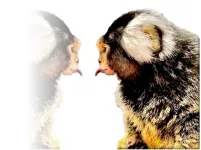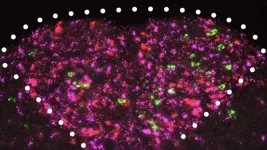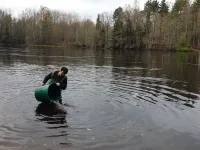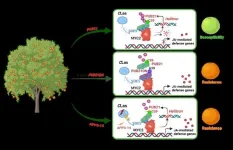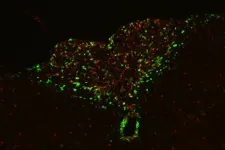(Press-News.org) Shoulders are, in many ways, a marvel. One shoulder has four separate joints, packed with muscles, that allow us to move our arm in eight different major ways, giving us the most degrees of freedom of any joint in the body. We can swim, toss, hug, and even punch because of the movement our shoulders enable.
But the same complexity that allows us such motion also presents opportunities for pain when something goes wrong. Another complication: shoulders change as we age, and new types of injuries come with it. Clinical practitioners face the daunting task of keeping up on the latest developments to treat a range of injuries as wide as Michael Phelps' wingspan.
“It’s not that shoulder problems are unique to one particular age or for one particular group of individuals, but rather that they can arise throughout our lifetime,” said Paul Salamh, visiting associate professor of rehabilitation sciences at Tufts University School of Medicine. “Because we ask our shoulders to do so much, they’re vulnerable to a wide range of issues.”
It can also be a challenge for health care providers to keep up with all of the latest evidence-based research on treating shoulder injuries. That’s why Salamh served as the lead author on two recently published papers, the research for which was conducted while he worked at the University of Indianapolis, about efforts to help coalesce this information and make it easier for everyone to understand.
In a paper published recently in the International Journal of Sports Physical Therapy, Salamh and other researchers conducted a systematic review of 19 papers on shoulder injuries. That review included four studies encompassing 7,802 athletes in baseball, handball, swimming, tennis, cricket, American football, and also multi-sport athletes and people in the military. The reason to focus on athletes, Salamh said, was because the rate of shoulder and elbow pain in athletes in these “overhead” sports is increasing. A 2022 study estimated that nearly 11% of athletes between the ages of 5 to 18 years old experience a shoulder injury.
Overall, the research team found five risk factors for athletes developing shoulder pain, two that can’t be changed (local and regional musculoskeletal pain) and three that can (range of motion, strength, and training load).
These findings are supportive of a drilling-down approach to risk factors specific to body region, sport, and where applicable, position played in that sport, said Salamh, who also serves as director of research for the Doctor of Physical Therapy Phoenix program at the School of Medicine. “There is a lot that can be looked at specifically in each sport. For example, the range of motion that would predispose a swimmer to a shoulder injury is different than that for someone playing lacrosse,” he said, adding that the same is true with strength of muscle or muscle groups within a particular sport.
In a paper published recently in the Journal of Manual and Manipulative Therapy, Salamh and a team of researchers addressed a decade’s worth of research on the risk factors, etiology, diagnosis, and management of frozen shoulder, an inflammatory condition that causes unrelenting stiffness and pain in the shoulder that can last for years.
For this paper, 14 international experts discussed and identified possible risk factors for the condition and symptoms that most often lead to a diagnosis. They also examined 33 different treatment options and categorized them into effectiveness for treating frozen shoulder in its earlier stages when pain is more prominent than stiffness, and later stages, when stiffness is a bigger problem than pain.
“The treatment we would intervene with varies significantly depending on the stage of the condition,” Salamh said. “Depending on where they are in this process, we could be doing something that could be more painful and create more problems for individuals than be helpful.”
Overall, Salamh hopes that these types of papers and future research can lead to better understanding of what this unique joint requires to stay healthy along the course of our lives. “We want to take the complexity of the shoulder and not simplify it but make it more manageable and digestible for patients, clinicians, and researchers,” he said.
Complete information on authors, methodology, limitations and conflicts of interest is available in the published papers.
END
Shouldering the burden of how to treat shoulder pain
New research paints a better picture of injuries that happen to an often-vexing joint
2025-04-10
ELSE PRESS RELEASES FROM THIS DATE:
Stevens researchers put glycemic response modeling on a data diet
2025-04-10
Hoboken, N.J., April 10, 2025 — If you eat a snack — a meatball, say, or a marshmallow — how will it affect your blood sugar? It’s a surprisingly tricky question: the body’s glycemic response to different foods varies based on individual genetics, microbiomes, hormonal fluctuations, and more. Because of that, providing personalized nutritional advice — which can help manage diabetes, obesity, and cardiovascular diseases, among other conditions — requires costly and intrusive testing, making it hard to deliver effective care at scale.
In a paper in the Journal of Diabetes Science and Technology, ...
Genotype-to-phenotype map of human pelvis illuminates evolutionary tradeoffs between walking and childbirth
2025-04-10
A combined study on the morphology of the human pelvis – leveraging genetics and deep learning on data from more than 31,000 individuals – reveals genetic links between pelvic structure and function, locomotion, and childbirth outcomes, researchers report. The findings offer fresh insights into how our species evolved to balance the competing demands of bipedalism and childbirth. The transition to bipedalism in hominins led to significant changes in pelvic morphology, including a shorter and wider pelvis, which facilitated an upright posture and efficient locomotion. However, ...
Pleistocene-age Denisovan male identified in Taiwan
2025-04-10
A fossil Pleistocene-age hominin jawbone discovered in Taiwan has now been identified as belonging to a Denisovan, according to a new paleoproteomic analysis of the remains. The findings provide direct molecular evidence that Denisovans occupied diverse climates, from the cold Siberian mountains to the warm, humid subtropical latitudes of Taiwan, and offer new morphological insights into this enigmatic hominin lineage. Recent research has revealed a surprising variety of ancient human relatives that lived in eastern Asia during the Pleistocene before modern humans arrived. One of the most important discoveries is the Denisovans, a distinct group identified through DNA ...
KATRIN experiment sets most precise upper limit on neutrino mass: 0.45 eV
2025-04-10
Researchers from the KATRIN (Karlsruhe Tritium Neutrino) experiment report the most precise measurement of the upper mass limit of the neutrino to date, establishing it as 0.45 electron volts (eV) – less than one-millionth the mass of an electron. The findings tighten the constraints on one of the universe’s most elusive fundamental particles and push the boundaries of physics beyond the Standard Model. Neutrinos – electrically neutral elementary particles – are the most abundant particles in the universe and ...
How the cerebellum controls tongue movements to grab food
2025-04-10
By studying the skilled movements of marmoset tongues, researchers have discovered that Purkinje cells (P-cells) in a brain region called the cerebellum signal to stop protrusion as the tongue approaches its target, according to a study published April 10th in the open-access journal PLOS Biology by Reza Shadmehr from Johns Hopkins School of Medicine, U.S., and colleagues.
We use our tongue to shape the air and generate sounds to communicate, and we use our tongue to evaluate food morsels and transport them through the oral cavity when eating. These skillful acts involve coordination of more ...
It’s not you—it’s cancer
2025-04-10
Cancer ravages both body and mind. If you’ve ever lost loved ones to the disease, you might recognize the physical and emotional changes cancer patients often endure during their final months. They seem drained of strength and spirit. Even people who’ve maintained a positive outlook throughout their lives can enter a state of despair. New research published in Science suggests apathy and lack of motivation are symptoms of a condition called cancer cachexia. Cold Spring Harbor Laboratory ...
Drug pollution alters migration behavior in salmon
2025-04-10
In the largest study of its kind to date, a team of international researchers has investigated how pharmaceutical pollution affects the behaviour and migration of Atlantic salmon.
The study, led by the Swedish University of Agricultural Sciences, revealed that commonly detected environmental levels of clobazam – a medication often prescribed for sleep disorders – increased the river-to-sea migration success of juvenile salmon in the wild.
The researchers also discovered that clobazam shortened the time it took for juvenile salmon to navigate through two hydropower dams along their migration route – obstacles that typically ...
Scientists decode citrus greening resistance and develop AI-assisted treatment
2025-04-10
In a groundbreaking study published in Science, a research team led by Prof. YE Jian from the Institute of Microbiology of the Chinese Academy of Sciences has identified the first mechanism of citrus resistance to citrus greening disease, or huanglongbing (HLB).
Utilizing artificial intelligence (AI), the team has also developed antimicrobial peptides that offer a promising therapeutic approach to combat the disease. This discovery addresses a long-standing challenge in the agricultural community—the absence of naturally occurring HLB-resistant genes in citrus.
Citrus ...
Venom characteristics of a deadly snake can be predicted from local climate
2025-04-10
Local climate can be used to predict the venom characteristics of a deadly snake that is widespread in India, helping clinicians to provide targeted therapies for snake bite victims, according to a study publishing April 10 in the open-access journal PLOS Neglected Tropical Diseases by Kartik Sunagar and colleagues at the Indian Institute of Science.
Russell’s viper (Daboia russelii) is found across the Indian subcontinent and is responsible for over 40% of snake ...
Brain pathway links inflammation to loss of motivation, energy in advanced cancer
2025-04-10
The fatigue and lack of motivation that many cancer patients experience near the end of life have been seen as the unavoidable consequences of their declining physical health and extreme weight loss. But new research from Washington University School of Medicine in St. Louis challenges that long-held assumption, showing instead that these behavioral changes stem from specific inflammation-sensing neurons in the brain.
In a study published April 11 in Science, the researchers report that they identified a direct connection between cancer-related inflammation ...
LAST 30 PRESS RELEASES:
Numbers in our sights affect how we perceive space
SIMJ announces global collaborative book project in commemoration of its 75th anniversary
Air pollution exposure and birth weight
Obstructive sleep apnea risk and mental health conditions among older adults
How talking slows eye movements behind the wheel
The Ceramic Society of Japan’s Oxoate Ceramics Research Association launches new international book project
Heart-brain connection: international study reveals the role of the vagus nerve in keeping the heart young
Researchers identify Rb1 as a predictive biomarker for a new therapeutic strategy in some breast cancers
Survey reveals ethical gaps slowing AI adoption in pediatric surgery
Stimulant ADHD medications work differently than thought
AI overestimates how smart people are, according to HSE economists
HSE researchers create genome-wide map of quadruplexes
Scientists boost cell "powerhouses" to burn more calories
Automatic label checking: The missing step in making reliable medical AI
Low daily alcohol intake linked to 50% heightened mouth cancer risk in India
American Meteorological Society announces Rick Spinrad as 2026 President-Elect
Biomass-based carbon capture spotlighted in newly released global climate webinar recording
Illuminating invisible nano pollutants: advanced bioimaging tracks the full journey of emerging nanoscale contaminants in living systems
How does age affect recovery from spinal cord injury?
Novel AI tool offers prognosis for patients with head and neck cancer
Fathers’ microplastic exposure tied to their children’s metabolic problems
Research validates laboratory model for studying high-grade serous ovarian cancer
SIR 2026 delivers transformative breakthroughs in minimally invasive medicine to improve patient care
Stem Cell Reports most downloaded papers of 2025 highlight the breadth and impact of stem cell research
Oxford-led study estimates NHS spends around 3% of its primary and secondary care budget on the health impacts of heat and cold in England
A researcher’s long quest leads to a smart composite breakthrough
Urban wild bees act as “microbial sensors” of city health.
New study finds where you live affects recovery after a hip fracture
Forecasting the impact of fully automated vehicle adoption on US road traffic injuries
Alcohol-related hospitalizations from 2016 to 2022
[Press-News.org] Shouldering the burden of how to treat shoulder painNew research paints a better picture of injuries that happen to an often-vexing joint
